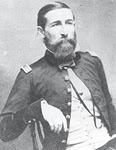Updated November 24, 2022

William Gilham is said to be the son of Henry Miller Gilham and Fanny Badollet who married 1 Apr 1815 in Knox County, Indiana and the grandson of William Gilham of Woodstock, Shenandoah County, VA and later merchant of the Town of Alexandria, VA.
William GILHAM (January 13, 1818-November 16, 1872) was an American soldier, teacher, chemist, and author. A member of the faculty at Virginia Military Institute, in 1860, he wrote a military manual which was still in modern use 145 years later. He served in the Confederate Army during the American Civil War, and became president of a fertilizer company after the War.
Childhood, education, military service
William GILHAM was born in Vincennes, Indiana, His father's family came from Virginia. He was appointed to the United States Military Academy at West Point, New York, where he graduated 5th in the class of 1840.
He became a lieutenant in the 3rd Artillery in the United States Army and fought in the Seminole War in Florida. From September 1841 to August 1844, he was Assistant Professor of Natural and Experimental Philosophy at the U.S. Military Academy (West Point). He served in the Mexican War in 1846. The degree of A. M. was conferred upon him by College of William and Mary in Williamsburg, Virginia in 1852.
Virginia Military Institute
In 1846, he became a professor at Virginia Military Institute (VMI), then a recently-founded state military college in Lexington, Virginia. During the next five years, he developed VMI's departments of Chemistry and Agriculture, taught infantry tactics and served as the Commandant of Cadets. To lighten the load on Major GILHAM, in 1851, VMI hired another professor, Major Thomas Jonathon Jackson, later better known as "Stonewall" Jackson, who was also a graduate of West Point, and a veteran of the conflicts in Florida and Mexico.
Majors GILHAM and Jackson taught together at VMI for the rest of the decade. In November 1859, at the request of the Virginia Governor Henry A. Wise, Major GILHAM led a contingent of the VMI Cadets Corps to Charles Town to provide an additional military presence for at the execution by hanging on December 2,1859 of militant abolitionist John Brown following his raid on the federal arsenal at Harper's Ferry. Major Jackson was placed in command of the artillery, consisting of two howitzers manned by 21 cadets.
In response to the raid on Harper's Ferry, Governor Wise ordered GILHAM to write a manual to train volunteers and militia. Finished in the fall of 1860, it was entitled Manual of Instruction for the Volunteers and Militia of the United States and was initially published in Philadelphia.
Family life
According to VMI records, while residing in Lexington, Major GILHAM and his wife Cordelia A. GILHAM (1826-1913) had 7 children, 3 born after moving to Virginia. Their daughter Emma Hayden GILHAM, born in 1855, was later one of Richmond's débutantes at the city's social "Germans" and married William Nelson Page, a civil engineer who became co-founder of the Virginian Railway. One of the GILHAM's sons, Julius Hayden GILHAM (April 6,1852 - March 10, 1936), is buried in Richmond's Hollywood Cemetery, as are Emma and William Page.
American Civil War
In 1861, as the American Civil War broke out, the Confederate Army had a lot of new recruits. Promoted to the rank of colonel, GILHAM became the Commandant of Camp Lee, at Richmond, Virginia, the camp of instruction for thousands of Virginians. GILHAM's manual proved to be the ideal book for the training of these young men.
Col. GILHAM briefly commended a brigade in the field during 1861 and 1862, but returned to teaching at VMI. On May 15, 1864, the VMI cadets participated in the Battle of New Market. GILHAM was present, but did not command the young troops during the battle. After Union troops raided Lexington, the VMI cadets were stationed at Richmond for the remainder of the War.
Post-war
After the War, VMI had no money to pay its instructors. GILHAM went to work in Richmond for Southern Fertilizer Company, which occupied the former Confederate Libby Prison facility near Richmond's Tobacco Row.
William GILHAM died in Vermont on November 16,1872 at the age of 53. He is buried at Lexington, Virginia in the Stonewall Jackson Memorial Cemetery, just a few yards from his friend and colleague for whom the cemetery was renamed.
Sources